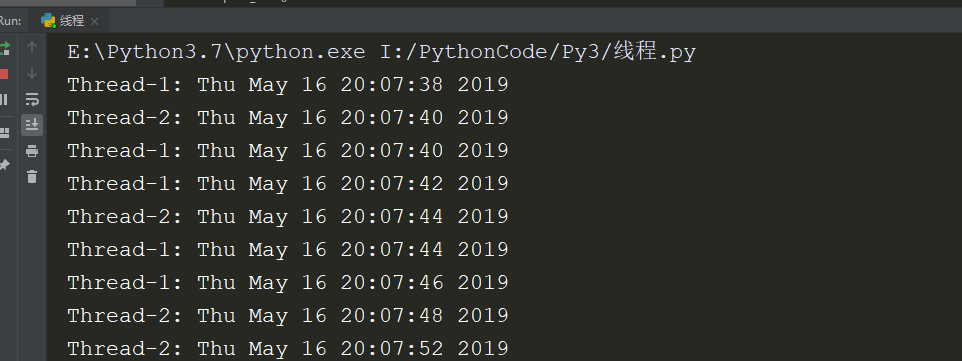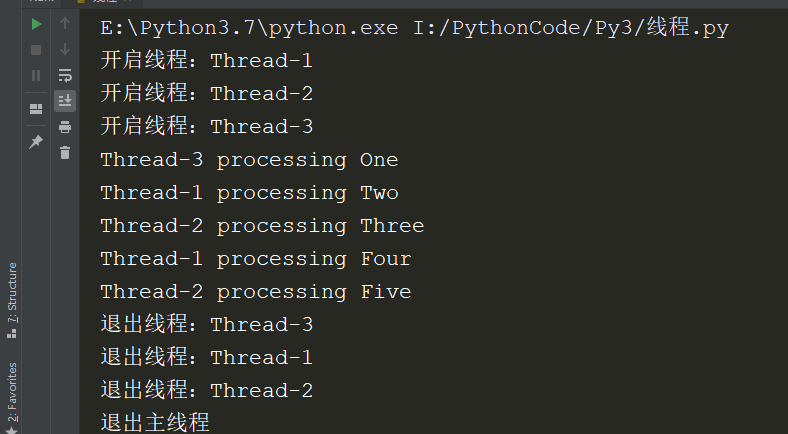这里做一个自己复习多线程的笔记
Python中使用线程有两种方式:函数或者用类来包装线程对象。
函数式:调用 _thread 模块中的start_new_thread()函数来产生新线程。语法如下:
参数说明:
- function - 线程函数。
- args - 传递给线程函数的参数,他必须是个tuple类型。
- kwargs - 可选参数。
实例:
#!/usr/bin/python3 import _thread import time # 为线程定义一个函数 def print_time( threadName, delay): count = 0 while count < 5: time.sleep(delay) count += 1 print ("%s: %s" % ( threadName, time.ctime(time.time()) )) # 创建两个线程 try: _thread.start_new_thread( print_time, ("Thread-1", 2, ) ) _thread.start_new_thread( print_time, ("Thread-2", 4, ) ) except: print ("Error: 无法启动线程") while 1: pass
运行结果:

线程模块
Python3 通过两个标准库 _thread 和 threading 提供对线程的支持。
_thread 提供了低级别的、原始的线程以及一个简单的锁,它相比于 threading 模块的功能还是比较有限的。
threading 模块除了包含 _thread 模块中的所有方法外,还提供的其他方法:
- threading.currentThread(): 返回当前的线程变量。
- threading.enumerate(): 返回一个包含正在运行的线程的list。正在运行指线程启动后、结束前,不包括启动前和终止后的线程。
- threading.activeCount(): 返回正在运行的线程数量,与len(threading.enumerate())有相同的结果。
除了使用方法外,线程模块同样提供了Thread类来处理线程,Thread类提供了以下方法:
- run(): 用以表示线程活动的方法。
- start():启动线程活动。
- join([time]): 等待至线程中止。这阻塞调用线程直至线程的join() 方法被调用中止-正常退出或者抛出未处理的异常-或者是可选的超时发生。
- isAlive(): 返回线程是否活动的。
- getName(): 返回线程名。
- setName(): 设置线程名。
使用 threading 模块创建线程
我们可以通过直接从 threading.Thread 继承创建一个新的子类,并实例化后调用 start() 方法启动新线程,即它调用了线程的 run() 方法:
#!/usr/bin/python3 import threading import time exitFlag = 0 class myThread (threading.Thread): def __init__(self, threadID, name, counter): threading.Thread.__init__(self) self.threadID = threadID self.name = name self.counter = counter def run(self): print ("开始线程:" + self.name) print_time(self.name, self.counter, 5) print ("退出线程:" + self.name) def print_time(threadName, delay, counter): while counter: if exitFlag: threadName.exit() time.sleep(delay) print ("%s: %s" % (threadName, time.ctime(time.time()))) counter -= 1 # 创建新线程 thread1 = myThread(1, "Thread-1", 1) thread2 = myThread(2, "Thread-2", 2) # 开启新线程 thread1.start() thread2.start() thread1.join() thread2.join() print ("退出主线程")
运行结果:

线程同步
如果多个线程共同对某个数据修改,则可能出现不可预料的结果,为了保证数据的正确性,需要对多个线程进行同步。
使用 Thread 对象的 Lock 和 Rlock 可以实现简单的线程同步,这两个对象都有 acquire 方法和 release 方法,对于那些需要每次只允许一个线程操作的数据,可以将其操作放到 acquire 和 release 方法之间。如下:
多线程的优势在于可以同时运行多个任务(至少感觉起来是这样)。但是当线程需要共享数据时,可能存在数据不同步的问题。
考虑这样一种情况:一个列表里所有元素都是0,线程"set"从后向前把所有元素改成1,而线程"print"负责从前往后读取列表并打印。
那么,可能线程"set"开始改的时候,线程"print"便来打印列表了,输出就成了一半0一半1,这就是数据的不同步。为了避免这种情况,引入了锁的概念。
锁有两种状态——锁定和未锁定。每当一个线程比如"set"要访问共享数据时,必须先获得锁定;如果已经有别的线程比如"print"获得锁定了,那么就让线程"set"暂停,也就是同步阻塞;等到线程"print"访问完毕,释放锁以后,再让线程"set"继续。
经过这样的处理,打印列表时要么全部输出0,要么全部输出1,不会再出现一半0一半1的尴尬场面。
实例:
#!/usr/bin/python3 import threading import time class myThread (threading.Thread): def __init__(self, threadID, name, counter): threading.Thread.__init__(self) self.threadID = threadID self.name = name self.counter = counter def run(self): print ("开启线程: " + self.name) # 获取锁,用于线程同步 threadLock.acquire() print_time(self.name, self.counter, 3) # 释放锁,开启下一个线程 threadLock.release() def print_time(threadName, delay, counter): while counter: time.sleep(delay) print ("%s: %s" % (threadName, time.ctime(time.time()))) counter -= 1 threadLock = threading.Lock() threads = [] # 创建新线程 thread1 = myThread(1, "Thread-1", 1) thread2 = myThread(2, "Thread-2", 2) # 开启新线程 thread1.start() thread2.start() # 添加线程到线程列表 threads.append(thread1) threads.append(thread2) # 等待所有线程完成 for t in threads: t.join() print ("退出主线程")
执行以上程序,输出结果为:

线程优先级队列( Queue)
queue队列
1.python3中的队列模块是queue,不是Queue
2.一般涉及到同步,多线程之类用到队列模块
3.定义了 queue.Queue 类,以及继承它的 queue.LifoQueue 类 和 queue.PriorityQueue 类 和 queue.SimpleQueue 类
4.分别对应队列类(FIFO先进先出),LIFO后进先出队列类,优先队列,无边界FIFO简单队列类
5.还有两个异常:队满和队空
队列queue公共方法
import queue #创建基本队列 #queue.Queue(maxsize=0)创建一个队列对象(队列容量),若maxsize小于或者等于0,队列大小没有限制 Q=queue.Queue(10) print(Q) print(type(Q)) #1.基本方法 print(Q.queue)#查看队列中所有元素 print(Q.qsize())#返回队列的大小 print(Q.empty())#判断队空 print(Q.full())#判断队满 #2.获取队列,0--5 #Queue.put(item,block = True,timeout = None )将对象放入队列,阻塞调用(block=False抛异常),无等待时间 for i in range(5): Q.put(i) # Queue.put_nowait(item)相当于 put(item, False). #3.读队列,0--5 #Queue.get(block=True, timeout=None)读出队列的一个元素,阻塞调用,无等待时间 while not Q.empty(): print(Q.get()) # Queue.get_nowait()相当于get(False).取数据,如果没数据抛queue.Empty异常 #4.另两种涉及等待排队任务的方法 # Queue.task_done()在完成一项工作后,向任务已经完成的队列发送一个信号 # Queue.join()阻止直到队列中的所有项目都被获取并处理。即等到队列为空再执行别的操作
其他
1.LifoQueue: LIFO后进先出
2.PriorityQueue:优先级队列,如果数据元素不具有可比性,则可将数据包装在忽略数据项的类中,仅比较优先级编号
3.SimpleQueue:简单队列,无跟踪任务的功能
Queue详细参数和用法实例
Queue 模块中的常用方法:
- Queue.qsize() 返回队列的大小
- Queue.empty() 如果队列为空,返回True,反之False
- Queue.full() 如果队列满了,返回True,反之False
- Queue.full 与 maxsize 大小对应
- Queue.get([block[, timeout]])获取队列,timeout等待时间
- Queue.get_nowait() 相当Queue.get(False)
- Queue.put(item) 写入队列,timeout等待时间
- Queue.put_nowait(item) 相当Queue.put(item, False)
- Queue.task_done() 在完成一项工作之后,Queue.task_done()函数向任务已经完成的队列发送一个信号
- Queue.join() 实际上意味着等到队列为空,再执行别的操作
实例:
import queue import threading import time exitFlag = 0 class myThread (threading.Thread): def __init__(self, threadID, name, q): threading.Thread.__init__(self) self.threadID = threadID self.name = name self.q = q def run(self): print ("开启线程:" + self.name) process_data(self.name, self.q) print ("退出线程:" + self.name) def process_data(threadName, q): while not exitFlag: queueLock.acquire() if not workQueue.empty(): data = q.get() queueLock.release() print ("%s processing %s" % (threadName, data)) else: queueLock.release() time.sleep(1) threadList = ["Thread-1", "Thread-2", "Thread-3"] nameList = ["One", "Two", "Three", "Four", "Five"] queueLock = threading.Lock() workQueue = queue.Queue(10) threads = [] threadID = 1 # 创建新线程 for tName in threadList: thread = myThread(threadID, tName, workQueue) thread.start() threads.append(thread) threadID += 1 # 填充队列 queueLock.acquire() for word in nameList: workQueue.put(word) queueLock.release() # 等待队列清空 while not workQueue.empty(): pass # 通知线程是时候退出 exitFlag = 1 # 等待所有线程完成 for t in threads: t.join() print ("退出主线程")
